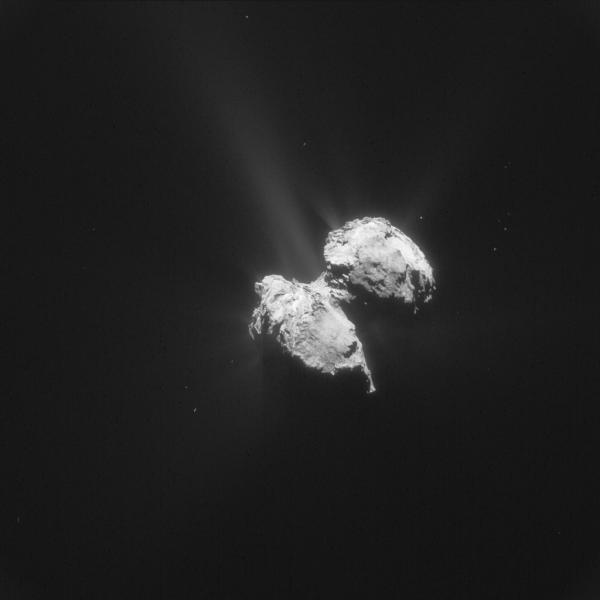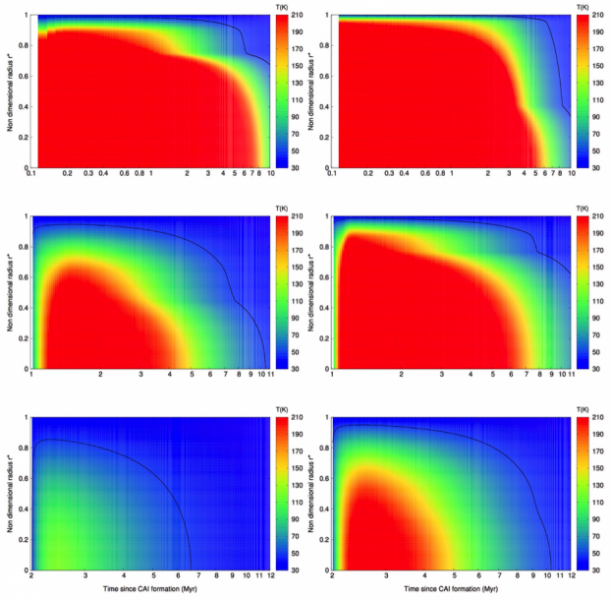The “Tchouri” comet took several million years to form
The heating produced by the disintegration of isotopes of aluminum and iron potentially present in the 67P / Churyumov-Gerasimenko comet would have been too intense at the beginning of the life of the protosolar nebula to explain the presence of materials at low temperature. Indeed, the presence of carbon monoxide, nitrogen or argon, as evidenced in 67P / Churyumov-Gerasimenko by the Rosetta mission, is only possible if the comet has formed after 2 to 8 Million years of evolution of the nebula so that it cools sufficiently and allows the comet to form, while keeping its materials more volatile. The other possibility is that the comet would have formed slowly over this entire interval of time, allowing it to preserve much of the ice it has acquired from the nebula. This is the result of a study led by researchers from the Marseille Astrophysics Laboratory (CNRS / Aix-Marseille University) and including an IRAP researcher (Université Paul Sabatier in Toulouse, CNRS and CNES). The study was published on April 6, 2017 in The Astrophysical Journal Letters.

The conditions of comet formation are still unknown. These objects have either agglomerated from building blocks directly formed in the protosolar nebula or from debris from the destruction of larger parent bodies. Under these conditions, the team simulated the influence of radiogenic heating on the structure and composition of icy bodies of sizes between the lobes of 67P/Churyumov-Gerasimenko (~2.6 km) and Comet Hale-Bopp (~70 km), using the canonical abundances of aluminum 26 and iron 60, the two nuclides whose decay is considered an important heat source for planetary bodies formed in the early history of the solar system.
The results of the study describe that it is both impossible to rapidly form 67P/Churyumov-Gerasimenko, or its parent body, and to preserve the volatile species observed in coma by the Rosetta mission. Simulations show that if growth was very rapid, the comet or its parent body must have formed between 2.2 and 7.7 million years after the appearance of the protosolar nebula. On the other hand, if the comet or its parent body accreted slowly, but always over the same time interval, then they were able to preserve the majority of their volatile species.
Shorter delays in formation or accretion, between 0.5 and 6.7 million years after nebula formation, are possible if one accepts that the deep interior of the comet or its parent body has been depleted in volatile species by radiogenic heating, and that the outer layers have remained ice-rich. However, if 67P/Churyumov-Gerasimenko formed from pieces from such a parent body, these would probably be a homogeneous mixture and it would be impossible to know whether these debris came from the inner or outer layers of the primitive object.
The main conclusion of this work is that the question of the origin and conditions of formation of the 67P/Churyumov-Gerasimenko building blocks remains unanswered. A return mission of samples to another comet of the Jupiter family will probably be necessary to bring new answers.

Further Resources
- Article : Impact of radiogenic heating on the formation conditions of comet 67P/Churyumov-Gerasimenko, O. Mousis, A. Drouard, P. Vernazza, J. I. Lunine, M., Monnereau, R. Maggiolo, K. Altwegg, H. Balsiger, J.-J. Berthelier, G. Cessateur, J. De Keyser, S. A. Fuselier, S. Gasc, A. Korth, T. Le Deun, U. Mall, B. Marty, H. Rème, M. Rubin, C.-Y. Tzou, J. H. Waite, and P. Wurz, The Astrophysical Journal Letters, 839:L4 (8 pp), 6 avril 2017
- CNRS/INSU Press Release : http://www.insu.cnrs.fr/node/6425
IRAP Contact
- Marc Monnereau, marc.monnereau@irap.omp.eu






